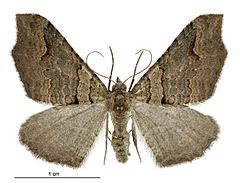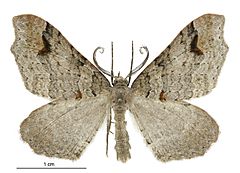Austrocidaria parora facts for kids
Quick facts for kids Austrocidaria parora |
|
|---|---|
 |
|
| Female | |
 |
|
| Male | |
| Scientific classification | |
| Kingdom: | |
| Phylum: | |
| Class: | |
| Order: | |
| Family: | |
| Tribe: |
Xanthorhoini
|
| Genus: |
Austrocidaria
|
| Species: |
A. parora
|
| Binomial name | |
| Austrocidaria parora (Meyrick, 1884)
|
|
| Synonyms | |
|
|
The Austrocidaria parora is a fascinating type of moth. It belongs to the family Geometridae, often called "geometer moths" or "loopers." This moth is quite special because it is endemic to New Zealand. This means you can only find it living naturally in New Zealand and nowhere else in the world!
Contents
How Scientists Named This Moth
This moth was first described by a scientist named Edward Meyrick in 1884. He first called it Harpalyce parora.
Over the years, scientists studied this moth more closely. They sometimes changed its genus name as they learned more about how different moths are related. For a while, it was known as Probolaea parora and then Asaphodes parora.
Finally, in 1988, another scientist named J. S. Dugdale placed this species in the genus Austrocidaria. This is the name we use for it today.
The original specimen used to describe the species, called a lectotype, is kept safe at the Natural History Museum in London.
What This Moth Looks Like
The Austrocidaria parora moth is a medium-sized moth. It usually has a wingspan of about 29 to 34 millimeters, which is a little over an inch.
Its front wings can be different colors. They might be light grey or a light reddish-brown. You can often see about eighteen wiggly, tooth-like darker lines across the wings. Some of these lines might be faint, while others are darker, even blackish.
Sometimes, there's a dark spot in the middle of the wing. The moth can also have a wide purplish-grey band in the middle of its wings. Near the edge of the wings, there's a row of small black dots.
The hind wings (back wings) are usually lighter. They can be whitish-grey or a very pale reddish-brown. They also have faint darker lines. Scientists say that the color of this moth can change quite a bit from one individual to another.
Where This Moth Lives
The Austrocidaria parora moth is found only in New Zealand. It is an endemic species, meaning it naturally lives nowhere else.
The very first specimen used to describe the species was found in Riccarton Bush in Christchurch. Since then, these moths have been seen in many other places across New Zealand.
Some of these locations include:
How This Moth Lives
Adult Austrocidaria parora moths can be seen flying at different times of the year. They have been recorded flying in January and February. They are also active later in the year, during August and September.
The young moths, which are called larvae or caterpillars, have a specific diet. They like to munch on plants from the Coprosma species. These plants are common shrubs and trees found in New Zealand.

